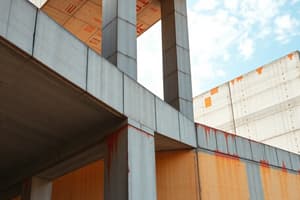Podcast
Questions and Answers
What are the design considerations for shear and torsional resistance in prestressed concrete members?
What are the design considerations for shear and torsional resistance in prestressed concrete members?
The design considerations include the design of shear reinforcement, reinforcement for torsion, shear, and bending.
Explain the stress distribution in the anchorage zone of post-tensioned members and the reinforcement used in this zone.
Explain the stress distribution in the anchorage zone of post-tensioned members and the reinforcement used in this zone.
The stress distribution in the anchorage zone involves the end block and the use of anchorage zone reinforcement.
Discuss the importance of deflections in prestressed concrete members and the factors affecting them.
Discuss the importance of deflections in prestressed concrete members and the factors affecting them.
The importance of deflections lies in the serviceability of the structure. Factors affecting deflections include short-term and long-term effects.
What are the advantages of continuous members in statically indeterminate structures, and how does prestressing affect them?
What are the advantages of continuous members in statically indeterminate structures, and how does prestressing affect them?
Signup and view all the answers
Discuss the concept of composite construction in prestressed concrete and its significance.
Discuss the concept of composite construction in prestressed concrete and its significance.
Signup and view all the answers
What is prestressed concrete and how is it different from conventional concrete?
What is prestressed concrete and how is it different from conventional concrete?
Signup and view all the answers
What are the types of materials used for tendons in prestressed concrete and how do they contribute to its performance?
What are the types of materials used for tendons in prestressed concrete and how do they contribute to its performance?
Signup and view all the answers
How does prestressed concrete improve structural capacity and serviceability compared with conventionally reinforced concrete?
How does prestressed concrete improve structural capacity and serviceability compared with conventionally reinforced concrete?
Signup and view all the answers
What are the characteristics of prestressed concrete under compression and tension forces?
What are the characteristics of prestressed concrete under compression and tension forces?
Signup and view all the answers
Explain the concept of tendons and their role in prestressed concrete.
Explain the concept of tendons and their role in prestressed concrete.
Signup and view all the answers





